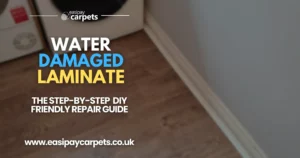

When To Repair Laminate Vs When To Replace, and How.
Laminate flooring is a popular choice due to its affordability, durability, and ease of installation. However, like any type of flooring, it is not immune to damage. If you’re wondering, “Can laminate flooring be repaired?” the answer is yes—in many cases, laminate can be repaired with some simple DIY techniques. However, there are also situations where replacing damaged boards is a better option. This guide will help you understand which types of damage can be repaired and how, as well as when it’s time to replace sections of laminate flooring and the steps involved.
Situations Where Laminate Flooring Can Be Repaired
Minor damage to laminate flooring, such as scratches, dents, chips, or small stains, can often be repaired with some basic DIY methods. Here’s a look at common types of damage and how to fix them:
1. Repairing Scratches on Laminate Flooring
Scratches are one of the most common issues with laminate flooring, especially in high-traffic areas or homes with pets. Light scratches can usually be repaired easily, while deeper ones may require more effort.
How to Repair Light Scratches:
- Materials Needed: Laminate floor repair kit (includes wax pencils or crayons), soft cloth.
- Instructions:
- Clean the scratched area with a damp cloth and let it dry completely.
- Choose a wax pencil or crayon that matches the colour of your laminate flooring.
- Rub the wax over the scratch until it is filled and blends with the surrounding area.
- Buff the area with a soft cloth to smooth out the repair and restore the shine.
How to Repair Deeper Scratches:
- Materials Needed: Laminate floor putty, putty knife, matching laminate colour paint (optional), clear sealant.
- Instructions:
- Clean the area thoroughly and let it dry.
- Apply laminate floor putty to the scratch using a putty knife, pressing it into the scratch to fill it completely.
- Smooth the putty with the putty knife and remove any excess.
- If needed, paint the repaired area with matching laminate colour paint for a seamless finish.
- Apply a clear sealant over the repair to protect it.
2. Fixing Chips in Laminate Flooring
Chips can occur when heavy objects are dropped on laminate flooring. Fortunately, they can be repaired without replacing the entire board.
How to Repair Chips:
- Materials Needed: Laminate floor repair kit (includes filler compound), putty knife, fine-grit sandpaper, matching colour marker (optional).
- Instructions:
- Clean the chipped area and ensure it is dry.
- Use the filler compound from the repair kit to fill in the chipped area. Smooth it with a putty knife.
- Allow the filler to dry according to the manufacturer’s instructions.
- Lightly sand the area with fine-grit sandpaper to smooth out the repair.
- If necessary, use a matching colour marker to blend the repair with the surrounding area.
3. Repairing Water Damage on Laminate Flooring
Water damage can cause laminate flooring to swell, buckle, or develop stains. Minor water damage, such as surface stains, can be repaired, but significant swelling may require board replacement.
How to Repair Minor Water Damage (Stains):
- Materials Needed: White vinegar, water, soft cloth, laminate cleaner.
- Instructions:
- Mix equal parts white vinegar and water.
- Dampen a soft cloth with the solution and gently rub the stained area.
- Rinse with a clean, damp cloth and dry immediately.
- For stubborn stains, use a laminate cleaner as directed by the manufacturer.
When to Replace Swollen or Buckled Laminate Boards:
If the laminate boards have swollen or buckled due to water exposure, they cannot be repaired and should be replaced. See the section below on replacing damaged boards.
4. Fixing Gaps Between Laminate Planks
Gaps can occur between laminate planks due to temperature changes, improper installation, or natural expansion and contraction. Most gaps can be fixed without replacing the boards.
How to Fix Gaps Between Planks:
- Materials Needed: Pull bar, rubber mallet, spacers.
- Instructions:
- Remove any baseboards or mouldings that cover the edges of the laminate floor.
- Use a pull bar and a rubber mallet to gently tap the planks back together, closing the gap.
- Reinstall the baseboards or mouldings to cover the expansion gap along the wall.
- Ensure there is still an expansion gap around the perimeter to prevent future gaps.
Situations Where Laminate Flooring Should Be Replaced
There are situations where the damage to laminate flooring is beyond repair, and the best solution is to replace the damaged boards. Here are some instances where replacement is necessary and how to do it:
1. Replacing Severely Damaged or Broken Boards
If laminate boards are severely cracked, broken, or have large chunks missing, they need to be replaced as they cannot be effectively repaired.
How to Replace a Damaged Laminate Board:
- Materials Needed: Replacement laminate planks, circular saw or jigsaw, utility knife, putty knife, wood glue, spacers.
- Instructions:
- Remove the Damaged Board: Use a circular saw or jigsaw to cut through the damaged board. Cut along the edges carefully to avoid damaging adjacent planks.
- Remove the Centre Piece: Use a utility knife or putty knife to lift and remove the cut pieces from the center.
- Prepare the Replacement Board: Trim the replacement board’s tongue and groove edges to fit into place. Apply wood glue to the edges.
- Install the New Board: Insert the replacement board into the opening and press it down firmly. Use spacers to ensure it is aligned correctly with the surrounding planks.
- Secure and Dry: Allow the glue to dry completely before walking on the floor.
2. Replacing Multiple Damaged Boards Due to Water Damage
Extensive water damage can cause multiple boards to swell, warp, or buckle. In such cases, replacing the affected section of flooring is the best approach.
How to Replace Multiple Laminate Boards:
- Materials Needed: Replacement laminate planks, circular saw or jigsaw, utility knife, laminate floor installation tools (spacers, pull bar, tapping block), moisture barrier (if necessary).
- Instructions:
- Remove the Affected Section: Start by removing the baseboards and locating the nearest edge of the room. Lift the planks in the affected area until all damaged boards are removed.
- Check the Subfloor: Ensure the subfloor is dry, clean, and level. If water damage reached the subfloor, allow it to dry completely or replace it if necessary.
- Install New Moisture Barrier (if needed): Lay a new moisture barrier under the replacement planks if the previous one was damaged.
- Install New Laminate Planks: Start laying the new planks, using spacers to maintain the expansion gap. Ensure the planks click into place securely using a pull bar and tapping block.
- Reinstall Baseboards: Once all the new planks are installed, reinstall the baseboards or mouldings to complete the repair.
3. Replacing Faded or Worn-Out Laminate Flooring
If the laminate flooring has faded over time due to sun exposure or wear and tear, or if it shows extensive damage across multiple boards, replacement is often the most practical solution.
How to Replace Worn-Out Laminate Flooring:
- Materials Needed: New laminate planks, underlayment, floor installation tools (spacers, pull bar, tapping block), moisture barrier.
- Instructions:
- Remove Old Laminate Flooring: Remove the baseboards and carefully lift the old laminate planks starting from the edges.
- Prepare the Subfloor: Clean and level the subfloor, ensuring it is free from debris or moisture.
- Install New Underlayment: Lay a new underlayment to provide cushioning and moisture protection for the new laminate.
- Install New Laminate Planks: Start from one corner of the room and work your way across, maintaining expansion gaps and locking each plank securely.
- Reinstall Baseboards: Reattach baseboards or mouldings for a finished look.
Conclusion
Laminate flooring is a durable and versatile flooring option, but like any material, it can suffer damage over time. In many cases, DIY laminate repair can effectively address issues such as scratches, chips, minor water damage, and gaps between planks. For more severe damage, such as broken boards, extensive water damage, or wear and tear across large sections, replacement may be the best solution. By understanding the types of damage and knowing when to repair or replace, you can keep your laminate floors looking great for years to come.
Easipay Carpets can help you get brand new flooring without the high up-front cost – by simply letting you spread the cost of the flooring over time instead. There’s no interest on our plans so you aren’t spending a penny more than you would buying it outright and we include underlay, door trims, carpet grippers and laminate beading for free. Prices start from just £10 per week!
It starts with a free home appointment and quote, to get booked in at a time that suits you, tap the “Get Started” button below and fill out the contact form!
Still Got Questions? Here's 10 FAQs!
Yes, laminate flooring can often be repaired in cases of scratches, chips, minor water damage, or gaps.
Light scratches can be repaired with a wax pencil, while deeper scratches may require laminate floor putty and a clear sealant.
Minor water stains can be cleaned, but swollen or buckled boards due to water damage should be replaced.
Remove the damaged board by cutting it out, prepare a replacement board by trimming its edges, and secure it with wood glue.
Replace laminate flooring if it has severe damage, extensive water damage, broken boards, or widespread fading and wear.
Common tools include a utility knife, putty knife, circular saw, pull bar, rubber mallet, and laminate floor repair kits.
Yes, damaged boards in the middle of the room can be replaced by carefully cutting out the damaged boards and installing new ones.
Prevent damage by using furniture pads, cleaning spills immediately, using area rugs in high-traffic areas, and maintaining a stable indoor environment.
Clean laminate floors with a damp mop and laminate-specific cleaner. Avoid excessive water and harsh chemicals.
No, laminate flooring cannot be sanded or refinished like hardwood, as it does not have a thick top layer of real wood.




